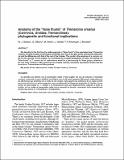Por favor, use este identificador para citar o enlazar a este item:
http://hdl.handle.net/10261/22444COMPARTIR / EXPORTAR:
 SHARE SHARE
 CORE
BASE CORE
BASE
|
|
| Visualizar otros formatos: MARC | Dublin Core | RDF | ORE | MODS | METS | DIDL | DATACITE | |

| Campo DC | Valor | Lengua/Idioma |
|---|---|---|
| dc.contributor.author | Salesa, Manuel J. | - |
| dc.contributor.author | Siliceo, Gema | - |
| dc.contributor.author | Antón, Mauricio | - |
| dc.contributor.author | Abella, Juan | - |
| dc.contributor.author | Montoya, Plinio | - |
| dc.contributor.author | Morales, Jorge | - |
| dc.date.accessioned | 2010-03-16T14:10:37Z | - |
| dc.date.available | 2010-03-16T14:10:37Z | - |
| dc.date.issued | 2006-12-30 | - |
| dc.identifier.citation | Estudios Geológicos 62(1): 389-394 (2006) | en_US |
| dc.identifier.issn | 0367-0449 | - |
| dc.identifier.uri | http://hdl.handle.net/10261/22444 | - |
| dc.description | 6 pages, 3 figures. | en_US |
| dc.description.abstract | [EN] We describe for the first time the radial sesamoid or “false thumb” of the spectacled bear (Tremarctos ornatus), showing its great morphological similarities with that of the giant panda (Ailuropoda melanoleuca) and the differences with that of the rest of the Ursidae. This points to the existence of a common origin for this structure in both species, but considering the accepted phylogenies of ursids, the sharing of a “false thumb” in T. ornatus and A. melanoleuca would be a plesiomorphy for these groups, whereas in the rest of the ursids the radial sesamoid was probably reduced, lacking the specialised function that this bone has in Tremarctinae and Ailuropodinae. | en_US |
| dc.description.abstract | [ES] Se describe por primera vez el sesamoideo radial o “falso pulgar” del oso de anteojos (Tremarctos ornatus), mostrando la gran similitud morfológica con el del panda gigante (Ailuropoda melanoleuca) y las diferencias que presenta con el resto de los Ursidae. Esto apunta a la existencia de un origen común para esta estructura en ambas especies, pero considerando las filogenias aceptadas de Ursidae, la presencia de falso pulgar en T. ornatus y A. melanoleuca sería una simplesiomorfía respecto al resto de úrsidos, en los cuales el sesamoideo radial nunca aumentó de tamaño, careciendo de la especializada función que posee en Tremarctinae y Ailuropodinae. | en_US |
| dc.description.sponsorship | This study is part of the research projects CGL2004-02094/BTE and CGL2005-03900/BTE (Secretaría de Estado de Universidades e Investigación, Ministerio de Educación y Ciencia). We thank Comunidad Autónoma de Madrid and Universidad Complutense de Madrid for the funding support (Research Group UCM-CAM 910607). | en_US |
| dc.format.extent | 335267 bytes | - |
| dc.format.mimetype | application/pdf | - |
| dc.language.iso | eng | en_US |
| dc.publisher | Consejo Superior de Investigaciones Científicas (España) | en_US |
| dc.rights | openAccess | en_US |
| dc.subject | Panda | en_US |
| dc.subject | Radial sesamoid | en_US |
| dc.subject | Ursidae | en_US |
| dc.subject | Ailuridae | en_US |
| dc.subject | Anatomy | en_US |
| dc.subject | Tremarctos | en_US |
| dc.subject | Sesamoideo radial | en_US |
| dc.subject | Anatomía | en_US |
| dc.title | Anatomy of the “false thumb” of Tremarctos ornatus (Carnivora, Ursidae, Tremarctinae): phylogenetic and functional implications | en_US |
| dc.type | artículo | en_US |
| dc.identifier.doi | 10.3989/egeol.0662133 | - |
| dc.description.peerreviewed | Peer reviewed | en_US |
| dc.relation.publisherversion | http://dx.doi.org/10.3989/egeol.0662133 | en_US |
| dc.identifier.e-issn | 1988-3250 | - |
| dc.type.coar | http://purl.org/coar/resource_type/c_6501 | es_ES |
| item.fulltext | With Fulltext | - |
| item.languageiso639-1 | en | - |
| item.openairecristype | http://purl.org/coar/resource_type/c_18cf | - |
| item.openairetype | artículo | - |
| item.cerifentitytype | Publications | - |
| item.grantfulltext | open | - |
| Aparece en las colecciones: | (MNCN) Artículos | |
Ficheros en este ítem:
| Fichero | Descripción | Tamaño | Formato | |
|---|---|---|---|---|
| 32.pdf | 327,41 kB | Adobe PDF |  Visualizar/Abrir |
CORE Recommender
Page view(s)
548
checked on 24-abr-2024
Download(s)
767
checked on 24-abr-2024
Google ScholarTM
Check
Altmetric
Altmetric
NOTA: Los ítems de Digital.CSIC están protegidos por copyright, con todos los derechos reservados, a menos que se indique lo contrario.
